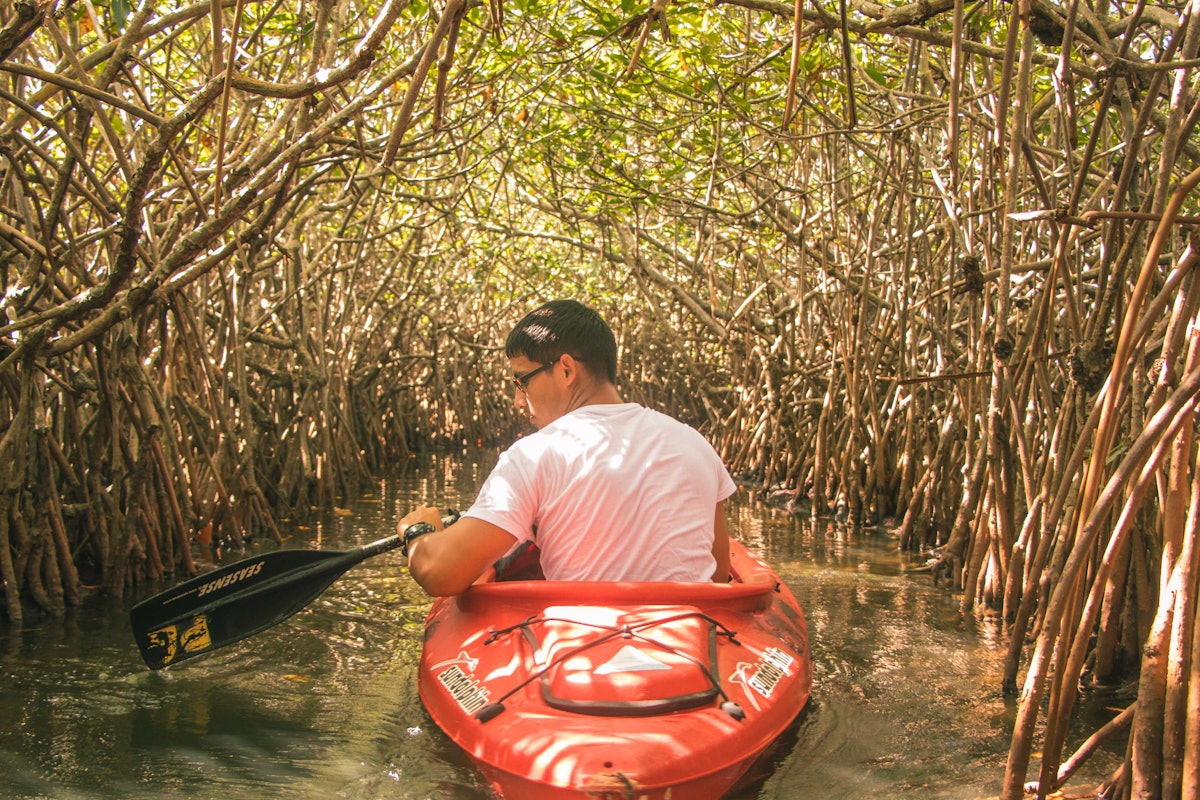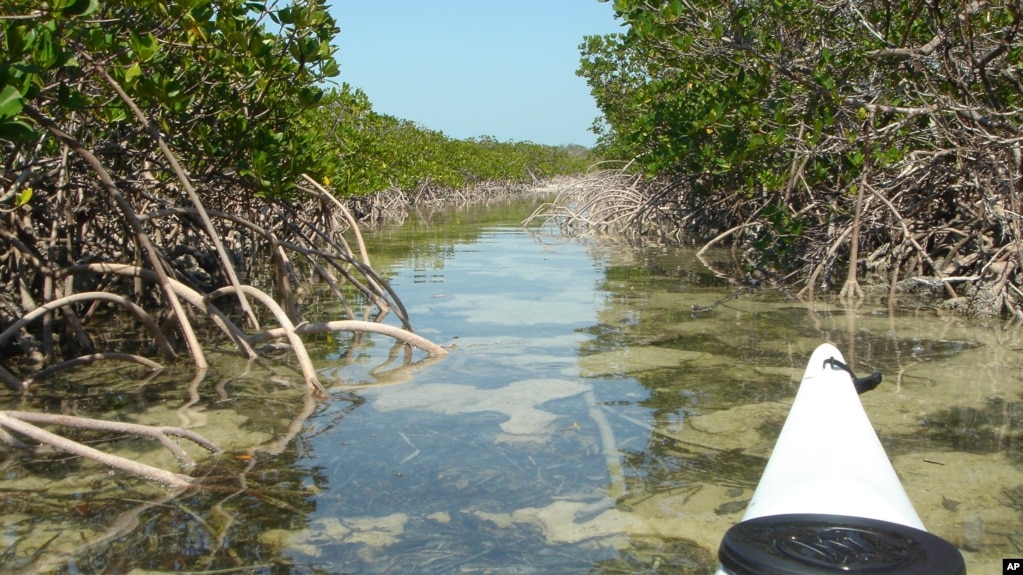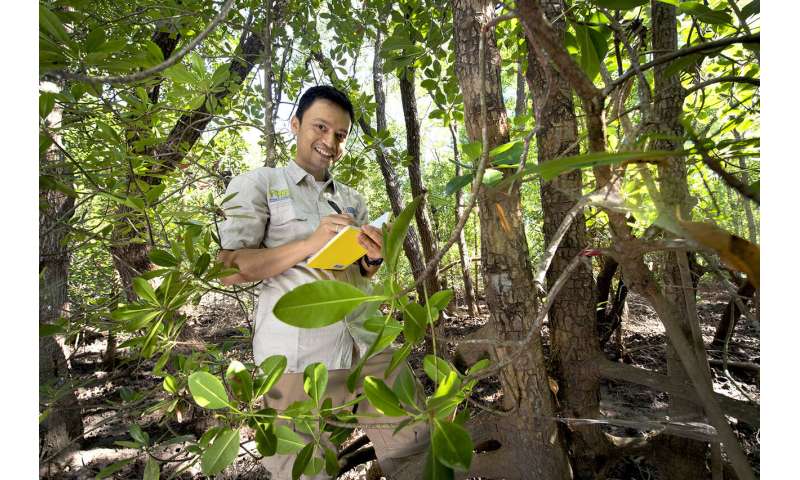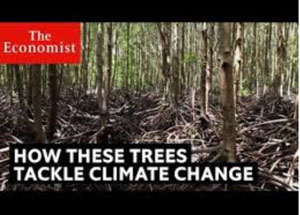FEATURE The Upside of Upside-Down Jellyfish

AUSTRALIA – The unexpected engineer of mangrove ecosystems is a jellyfish that swims the wrong way. At first glance, Cassiopea jellyfish may seem like ridiculous failures. Unlike most jellyfish that swim with their bells pointed up, these so-called upside-down jellyfish spend most of their time with their bells resting on the seafloor of shallow, still coastal waters. There, they persistently pulse as if on a Sisyphean quest to burrow through the planet. Now, new research suggests these creatures’ flailing may play an important role in flooded mangrove forests. The results of research published as a pre-print study show that the jellies’ pulsing causes a surprising amount of mixing in the water. An average-sized Cassiopea can send a water jet several meters upward, and at median densities on the seafloor, a group of jellies can mix a one-meter column of water every 15 minutes. Cassiopea move an order of magnitude more water than filter-feeding animals such as oysters and mussels, even when accounting for the size differences between species. The research suggests these jellyfish may be indirectly reshaping their habitats through nutrient and gas mixing, making them ecosystem engineers similar to dam-building beavers or hole-drilling woodpeckers. “It’s quite clear that there are no other species that create as much turbulence in the mangroves,” says Eric Wolanski, a coastal oceanographer at James Cook University in Australia who was not involved in the research. READ MORE GLOBAL The economics of mangroves through nighttime satellite photos

GLOBAL – Mangroves are pretty incredible. They are the only type of trees capable of living in saltwater and perform a ton of beneficial services for the environment and humans like providing critical habitat to important fish species and reducing the amount of carbon dioxide in the atmosphere. Now, thanks to new research published in the Proceedings of the National Academy of Sciences, we can add “protecting coastal economies” to the list. Coastal mangrove forests serve as a barrier between oceans and human settlements on land. In the midst of tropical storms, mangroves buffer shorelines from damage by reducing wave action and storm surges. As the strength and frequency of hurricanes increases as a result of climate change, scientists and economists have been wondering just how much economic value these barrier forests provide as they protect us from storms. To find out, researchers studied how coastal areas in Central America fared during hurricanes from 2000 – 2013. Unfortunately, it can be difficult to get a full picture of the economic impacts of storms so researchers relied on an interesting indicator of economic activity: the appearance and amount of lights visible in an area in satellite imagery at night. More lights in an area equates to more infrastructure and activity, which tends to correlate to higher income and economic activity. By comparing the images of lights in an area before and after storms, scientists were able to judge just how much damage the area had sustained and how long the area was likely facing an economic downturn post-hurricane. READ MORE AMERICA Amber light turns green for Pemex to plow through protected mangroves

MEXICO – In southern Mexico, as in other similar climatic zones throughout the tropics, an extraordinary feature of the environment works tirelessly away upon the coast. Across countless marine shorelines and river estuaries you’ll find them doing what they can to reverse man-made climate damage. Here are the world’s greatest carbon scrubbers; their value, until recently, has been unquestionable. The mangroves that exist in the tropical climes of the Caribbean and Central America are a vital feature of the region’s natural arsenal against carbon — aquatic trees that are adapted to harsh coastal conditions and absorb carbon dioxide for long-term storage, a unique process that makes them some of the most valuable resources in tackling the carbon crisis. Their ability to effectively filter polluted seawater as well as oxygenate the air led to them being declared a protected entity, beyond the reach of large-scale companies capable of mass deforestation of areas heavily populated by mangroves. Since then however, the conversation around the preservation of these sites has begun to regress, the tipping point being when President López Obrador offered the green light to Pemex to begin construction on a US $8-billion oil refinery over mangroves in Dos Bocas, Tabasco. READ MORE Keep Mangrove Forests to Prevent Flooding, Soil Loss

USA – Disappearing natural resources like mangrove forests are important to reduce flooding in low-lying coastal areas like southern Florida, scientists say. Mangrove trees grow in coastal wetlands. Unlike other trees, they can grow in salty seawater. Their roots form a dense barrier that helps prevent erosion and controls the force of incoming water from tides and ocean storms. Scientific studies do not agree on how high tides and rising seas linked to climate change will affect Florida. However, the U.S. National Oceanic and Atmospheric Agency, or NOAA, predicts that the sea level could rise by as much as two meters by the year 2100. If that happens, large areas of Florida would be underwater. Environmental scientist Margarita Kruyff is trying to develop ways to limit the damage from flooding and rising seas. She said, “We’re trying to project how fast we’re expecting them to rise so we can plan how we’re going to protect our communities for the future.” Laura Geselbracht is a marine scientist in Florida. She works for the environmental group Nature Conservancy. She says mangrove forests like the ones in Oleta River State Park near Miami Beach provide protection against flooding. “Even though this area is surrounded by a lot of high development, the mangroves will help reduce flooding,” she said. READ MORE New Hope for Migratory Shorebirds

GUATEMALA – Up and down the Pacific Coast of Guatemala, the sea's edge gives way to volcanic sand, and zones of life that change with the tides and currents. Come dawn, at a low ebb; the receding water exposes mudflats like clay tablets dimpled with the zigzagging footprints of shorebirds. Sandpipers scurry across the soft earth by mangroves, flying in from their high-tide roosts to feed. Pelicans huddle by the dozens, commanding the scene with their iconic bills and gregarious nature. We glide through the estuary in our slender wooden boat to survey the waves of morning birds and drift close to flocks before they flush—the sky a commotion of wings and wails. In our day-to-day lives, we see birds as a mere detail in our scenery, in our backyards, in our parks, backdrop. But here, in the tidal flats and mangrove forests, their presence is commanding. We are the visitors. This protected estuary and lagoon of El Paredón, a small beach town with a trickling of tourism, sits in the middle of Sipacate-Naranjo National Park. It offers sanctuary to local and migratory shorebirds who depend on the refuge of mudflats, mangroves and estuaries, and the bounty of fish, crustaceans and other critters. Local species use this habitat year-round; travelers stop over to recuperate. READ MORE Mangrove Forests Protect Miami From Rising Tides

USA – It’s a sunny day in Miami, Florida with no chance of rain. But according to environmental scientist Margarita Kruyff, even on days like this, low-lying coastal communities like Miami and nearby Miami Beach may experience periodic flooding because of the porous bedrock underground that leaks water. “On the roads it means water could be coming up our drainage systems,” said the City of Miami Beach environmental scientist, who explained that the annual seasonal King Tides, or very high tides, also take their toll. “Water may be coming up over seawalls for our residents, causing flooding in their homes and back yards,” she said. WATCH VIDEO ASIA Bucking global trends, Southeast Asian mangrove destruction is rampant

MYANMAR -Southeast Asia’s aggressive development to spur economic growth and feed its growing populations is stripping the region’s coasts of mangrove forests at rates faster than anywhere, new research shows. Although the rates of their loss are in decline globally, mangroves in Southeast Asia today continue to face persistent man-made threats, experiencing loss rates twice the global average, an international team of researchers has found. Driving such rapid deforestation are the mangrove-rich region’s rising aquaculture, rice and palm oil farming, industrial activity and coastal development, reads the study, led by National University of Singapore (NUS). Early twenty-first-century global mangrove destruction rates have been almost 10 times lower than those reported for previous decades due to better protection and shrinking forest areas available for conversion. But the future of mangroves in Southeast Asia, home to almost one third of the planet’s mangroves, is uncertain, with coasts still being stripped of these salt-tolerant forests in nations such as Myanmar, Malaysia, the Philippines and Indonesia. READ MORE Five trees or a latte? Coastal communities seek crowdfunding for mangroves

MALASIA – Would you forgo a cup of coffee to plant mangroves aimed at helping coastal communities fend off climate change? A Singapore-based online platform is counting on crowdsourcing donations for projects to add 1 billion mangrove trees by 2025. The Global Mangrove Trust plans to launch an app and website in the next six months using blockchain technology to fund mangrove restoration projects across India and Southeast Asia. Users will be able to select a project and, once the funding target is met, track its progress through video, photograph and data updates, and monitor forest growth drawing on satellite images and algorithms. “We provide an opportunity for people all over the world who have excess money (to) lay off one $5 latte and plant five mangrove trees with a coastal community,” said Ryan Merrill, the trust’s managing director. The trees, together with related employment and conservation efforts, offer an opportunity to provide “a disproportionate benefit for the most vulnerable”, he added. Mangroves make up less than 1% of tropical forests worldwide but are vital for the well-being, food security and protection of coastal communities, according to the United Nations Environment Programme (UNEP). READ MORE Mangroves could turn tide on carbon output

INDONESIA – Research has found that changes in current land management practices in the mangrove forests of West Papua Province, Indonesia could have significant impacts on the country's future emission reduction targets. The research published in Global Change Biology found that future escalation of land-use change in Papua mangroves could have implications for Indonesia's Nationally Determined Contributions (NDCs) under the Paris Agreement of 2015. Charles Darwin University's Research Institute for the Environment and Livelihoods Ph.D. candidate Sigit D. Sasmito said current land management practices in Papua's mangroves reduced carbon stocks substantially. "Our evaluation of blue carbon stocks and their potential emissions and removals suggest that current land management practices in Papua's mangroves, such as forest harvesting and small-scale aquaculture, reduced carbon stocks substantially," Sigit said. "Given the Papua mangrove estate accounts for 50% of Indonesia's 2.9 million hectares of mangrove area, the region is clearly an important asset for nature-based climate change mitigation policy." READ MORE How Asia’s megacities can benefit from mangroves and other natural climate solutions

SINGAPORE – The loss of mangroves and other coastal habitats has been linked to more frequent and severe flooding in adjacent villages and cities. What can urban dwellers, local governments and businesses do to support nature-based solutions? Cities, even those sited away from coastal areas, can benefit from nature-based solutions such as the restoration of mangroves and coral reefs to combat rising sea levels and global warming. But what measures should communities roll out for the best outcomes and greatest return on investment? As the man tasked to set up the new Centre for Nature-based Climate Solutions at the National University of Singapore (NUS), these are some of the questions that conservation scientist Koh Lian Pin aims to help governments and corporate leaders in the Asia Pacific address. The centre is expected to be operational by the end of this year. READ MORE
Like this newsletter?
Pease consider donating to MAP to keep it going.
Giving could never be easier | ACTION ALERTS Enough! Pledging zero tolerance to attacks against environmental and human rights defenders. SIGN THE PETITION PETITION – Sea turtles or condominiums?
Sand mining and construction work would wipe out a marine biodiversity hotspot and destroy the livelihoods of local people, who have not been consulted. Please SIGN! PETITION – Save Penang! Reject the 3-Islands Reclamation!
The lack of public consultation and detailed information about the project is shocking in view of the size of proposed reclamation which is 4,500 acres or 7 square miles
PLEASE SIGN
PETITION – Save Pulau Kukup National Park – second largest mangrove island in the world. Sign The Petition Like this newsletter? Pease consider donating to MAP to keep it going. Giving could never be easier 
Mangrove Restoration Map VIEW MAP HERE 
Restoring The Natural Mangrove Forest
Watch movie 
Community Based Ecological Mangrove Restoration in Rufiji Delta VIEW VIDEO Video: Mangroves for the Future – A look bacK. As the latest phase of Mangroves for the Future (MFF) draws to a close, this video highlights some of the project’s most successful initiatives – from local women supporting national park management in Viet Nam to an island in the Maldives that has become a model for waste management, and everything in between. View Here WANT TO GET INVOLVED?
Follow and Join MAP!
   
Like this newsletter? Pease consider donating to MAP to keep it going. Giving could never be easier 

VOLUNTEER OPPORTUNITY 
MANGROVE ISSUES Want to learn more about mangroves?
Our short presentation will give you a better understanding of the issues we are working to solve. WATCH PRESENTATION What is CBEMR? Easy to follow fact sheet – CLICK HERE What is EPIC? – The Ecosystems Protecting Infrastructure and Communities (EPIC) project: the role of ecosystems as protective barriers against climate induced hazards MANGROVES APP AVAILABLE
A pictorial field guide for easy identification of various mangrove species and learning about the mangroves ecosystem. CLICK HERE View MAP’s uploaded Videos at MAPmangrover’sChannel
Question Your Shrimp Consumer/Markets Campaign!
WATCH VIDEO WATCH – Mangroves: how they help the ocean
 Mangrove Restoration in Asia – Watch Short Video The Value of Mangrove Forests View Video CBEMR Experience Exchange MAP 2017 English Subtitles
VIEW THE VIDEO Mangroves: Guidebook to Malaysia – Click Here
Mangrove rehabilitation in Asia – Local Action and cross-border Transfer of Knowledge for the Conservation of Climate, Forests and Biodiversity VIEW VIDEOS HERE SHARE MAP'S VISION
CLICK HERE to watch short introductory video. Together we can work "at the roots of the sea". Our short documentary, Reducing the Risk of Disaster through Nature-Based Solutions : Mangroves

Exclusive Interview with Alfredo Quarto, Co-Founder and Executive Director of Mangrove Action Project – See more
Marvellous Mangroves Curriculum The Marvellous Mangroves Education Forum is an online hub for those utilizing the Marvellous Mangroves (MM) Curriculum. It gives students, teachers and anyone interested in mangroves, the opportunity to learn and share ideas themed around the curriculum, to connect and communicate with others around the globe whilst exploring mangroves from your computer or on the go. VISIT 
The award-winning Marvellous Mangroves (MM) curriculum educates children on the importance of mangroves and their ecological functions, teaching them about modern challenges and mechanisms for sustainability. VIEW VIDEO Marvellous Mangroves Curriculum in Bangladesh – WATCH VIDEO
MARVELLOUS MANGROVES IN BRAZIL
En Portuges 
Marvellous Mangroves – A Curriculum-Based Teachers Guide. FOR MORE ON MAPs AWARD WINNING CHINA MANGROVE CURRICULUM VISIT

VIMEO SHOW
VISIT OUR "MM" WEBPAGE Check out our presentation for more details on Marvellous Mangroves Read this 10 page history of the development of MAP’s educational curriculum VIEW DOCUMENT
Article in Canada's Green Teacher Magazine – Read More
Like this newsletter? Pease consider donating to MAP to keep it going. Giving could never be easier 
Green Planet Fundraising Assists MAP – LEARN MORE
Volunteer Opportunities with Mangrove Action Project CLICK HERE
"Question Your Shrimp" Campaign Question Your Shrimp- Don't Buy or Sell Imported Tropical Shrimp! Sign the Petition Learn more about the affects of the shrimp industry on mangroves by visiting our blog
Editor’s Note: Mangrove Action Project’s Executive Director, Alfredo Quarto was interviewed about shrimp by Green Acre Radio’s Martha Baskin
LISTEN TO INTERVIEW Sign the Consumer's Pledge to avoid imported shrimp
Not yet a MAP News subscriber?
Click here to subscribe. Note to Our Readers: We strive to keep active links in our newsletter. However, due to circumstances beyond our control, occasionally links to stories may become broken. If you find a link to a story is not functioning, please cut and paste the headline into your browser search bar. In most cases you should be able to locate the original story.
|

























